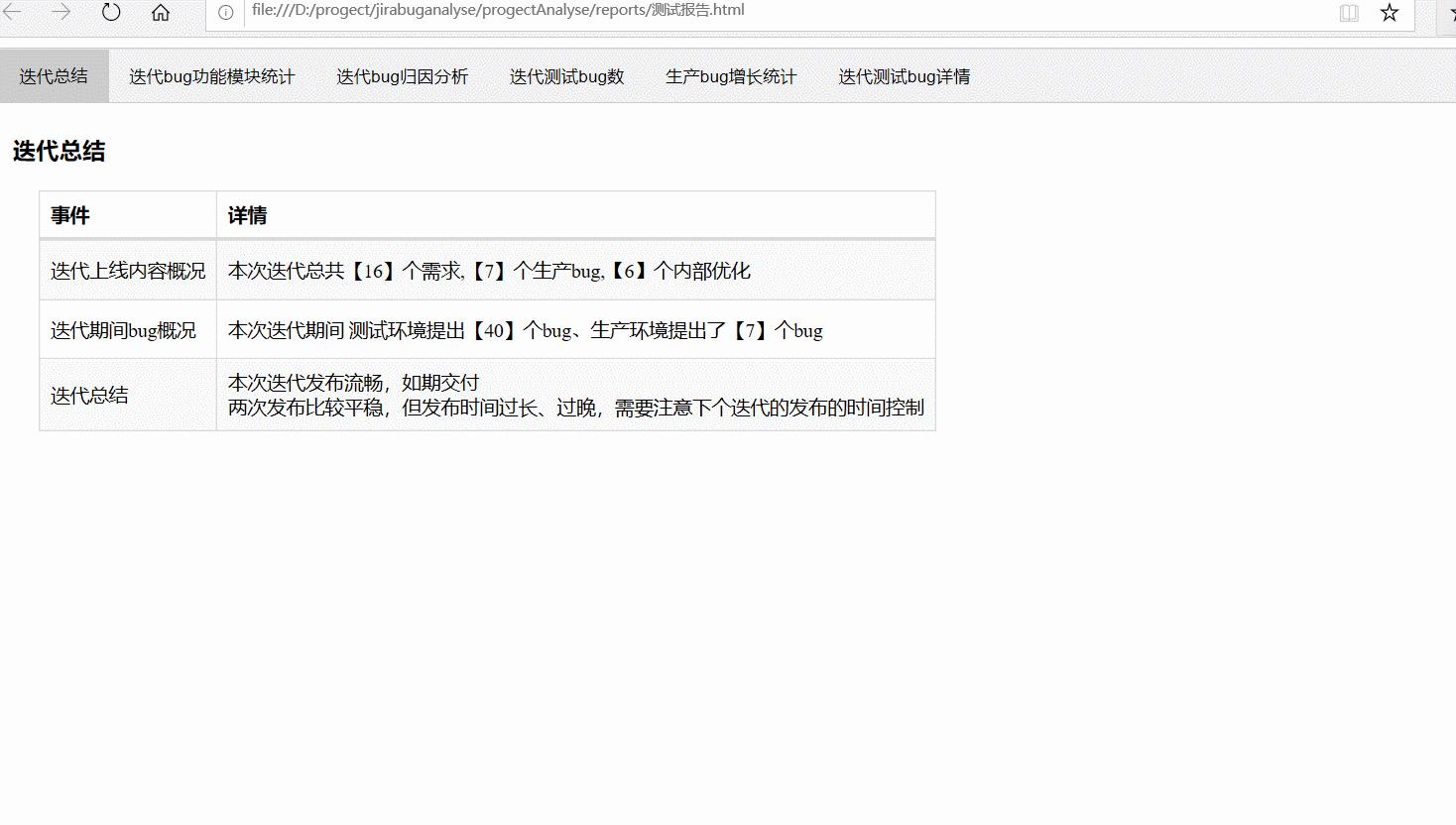背景:
我本人不愿意写测试报告,但领导规定每个迭代后都需要发一份测试报告,让我比较难受(不是不会写,主要是测试报告内容比较详实,几乎没有人会细看),没有人看就=流于形式
那么,有没有一种方法,既满足了减轻测试人员的压力,又完成了目标,同时还能整合出一个一目了然的且具有参考意义的测试报告呢?
过程:
首先,因为我们公司使用jira作为迭代管理工具,我想了一下,如果能把jira数据拉下来就好了,于是我去查了一下,发现python是可以对jira进行操作的,那么就可以开整了
我的思路是这样的
1、利用python操作jira获取到我们的预期的数据
2、对数据进行处理,是数据满足我们生成图表的要求
3、使用pychart将处理好的数据变成测试报告的html
4、集成到jenkins上并接受他人的传参,做成千人千面,大家都可以使用的工具
先安装jira和pyecharts
在cmd中运行以下命令
pip install pyecharts
pip install jira

然后新建一个py文件,定义一些操作jira的方法,解析数据的方法,并返回满足生产图片的数据
operationJira.py
from jira import JIRA
class jiraOperation():
def loginJira(server,username,password):
jira = JIRA(server = server,basic_auth =(username,password))
return jira
#登录jira并返回一个jira的实例
def serchissues(jira,jql,max_results = 50000,fields='components,summary,customfield_10903,labels'):
"""serchiuess
@:param jql:JQL,str
@:param max_results: max results,int,default 100
"""
try:
issues = jira.search_issues(jql,fields=fields, maxResults=max_results)
#默认返回指定的三个字段,且最大结果行为50000
return issues
except Exception as e:
print(e)
#根据jql查询jira的信息
def analytical(jira_result):
summarys = {}
components = {}
custom_fields = {}
reason_bugs = {}
for x in jira_result:
a = str(x.fields.summary) #概要
if x.fields.components == []:
b = 'None'
else:
b = str(x.fields.components[0]) #模块 返回的是一个jira的components对象 需要转成str
c = str(x.fields.customfield_10903) #归因分析
d = str(x.key) #jira号
e = str(x.fields.labels[0])
summarys.setdefault(d,a) #{jira号:概要}
components.setdefault(b,0) #{模块:出现次数}
if b in components.keys():
components[b] = components[b] + 1
custom_fields.setdefault(c,0) #{归因分析:出现次数}
if c in custom_fields.keys():
custom_fields[c] = custom_fields[c] + 1
reason_bugs.setdefault((d+a),c) #{jira号 jira概要:jira归因分析}
labels = e
return (summarys,components,custom_fields,reason_bugs,labels)
#解析jira数据并返回数据有了,接下来就是根据数据生成图表了
makeChart.py
# -*- coding=utf-8 -*-
from pyecharts.faker import Faker
from pyecharts import options as opts
from pyecharts.charts import Bar, Line,Pie,Tab,Page,Timeline
from pyecharts.components import Table
from pyecharts.options import ComponentTitleOpts
class charts():
def make(jira_finail_result):
timeline_bar = Timeline().add_schema(is_auto_play=True,pos_top='7.5%',height='2%')
timeline_pie = Timeline().add_schema(is_auto_play=True,pos_top='7.5%',height='2%')
line_name = []
line_data = []
for jira_result in jira_finail_result:
summarys = jira_result[0]
components = jira_result[1]
custom_fields = jira_result[2]
reason_bugs = jira_result[3]
labels = jira_result[4]
x = Faker.choose()
bar = (
Bar()
.add_xaxis(list(components.keys()))
.add_yaxis("", list(components.values()))
# .reversal_axis() #横向展示
.set_global_opts(title_opts=opts.TitleOpts("{}".format(labels)),
xaxis_opts=opts.AxisOpts(name_rotate=30, axislabel_opts={"rotate": 30})))
timeline_bar.add(bar,'')
#柱状图
pie = (
Pie()
.add("2", [list(z) for z in zip(list(custom_fields.keys()), list(custom_fields.values()))],
radius=["40%", "70%"],
label_opts=opts.LabelOpts(
position="outside",
formatter="{b}:{c}\n{per|{d}%}",
background_color="#eee",
border_color="#aaa",
border_width=1,
border_radius=2,
rich={
"a": {"color": "#989", "lineHeight": '44%', "align": "center"},
"abg": {
"backgroundColor": "#e3e3e3",
"width": "30%",
"align": "right",
"height": 21,
"borderRadius": [0, 0, 0, 0],
},
"hr": {
"borderColor": "#aaa",
"width": "71%",
"borderWidth": 12,
"height": 12,
},
"b": {"fontSize": 15, "lineHeight": 10},
"per": {
"color": "#eee",
"backgroundColor": "#324456",
"padding": [0.5, 0.5],
"borderRadius": 1,
},
},
),
)
# .set_global_opts(title_opts=opts.TitleOpts(title="标题")) #小标题
.set_global_opts(legend_opts=opts.LegendOpts(pos_left='83%'),
title_opts=opts.TitleOpts(title="{}".format(labels)),
tooltip_opts=opts.TooltipOpts(is_show=False, ))
)
timeline_pie.add(pie, "")
#饼图
line_name.append(labels)
line_data.append(len(summarys))
analysetable = (
Table()
.add( ["事件",'详情'],
[
['需求情况','填写实际的迭代的需求情况'],
['bug情况','填写实际的迭代的bug情况'],
['总结','对本次发布进行总结']
]
)
.set_global_opts(title_opts=ComponentTitleOpts(title="迭代总结"))
)
#表格
bug_list = []
for one in reason_bugs:
bug_list.append([reason_bugs[one],one])
bugtable = (
Table()
#.add(["bug原因", 'jira号 概要'], [[1, 'sha'], [1, 2]]) # demo样例
.add(["bug原因", 'jira号 概要'], bug_list)
.set_global_opts(title_opts=ComponentTitleOpts(title="Bug归因列表"))
)
#bug列表清单
line = (
Line()
.add_xaxis(line_name,)
.add_yaxis("迭代测试bug数",line_data, is_smooth=True)
.set_series_opts(textstyle_opts=opts.TextStyleOpts(font_size=50))
.set_global_opts(title_opts=opts.TitleOpts(title="迭代测试bug数"),
xaxis_opts=opts.AxisOpts(name_gap=500,name_rotate=30,axislabel_opts={"rotate": 30},
)
)
)
#折线图
report_name = '测试报告'
tab = (
Tab()
.add(analysetable,'迭代总结')
.add(timeline_bar, '迭代bug功能模块统计')
.add(timeline_pie,'迭代bug归因分析')
.add(line,'迭代测试bug数')
.add(bugtable, 'bug列表')
)
#标签页
tab.render('''../reports/''' + str(report_name) + ".html")
#以标签页为格式生成图表再创建一个run.py文件来调用前两个文件
from script.operationJira import jiraOperation
from script.makeChart import charts
jira = jiraOperation.loginJira('url','username','password')
#登录jira 这个地方填写自己公司的jira地址和账号密码
jira_jql = [
"""labels = 1128迭代测试bug ORDER BY component DESC""",
"""labels = 1219迭代测试bug ORDER BY component DESC""",
"""labels = "2020/1/9" ORDER BY component DESC""",
#"""labels = "2020/1/9" ORDER BY component DESC""",
]
#每个迭代的jql放进去就好了
jira_finail_result = []
for jql in jira_jql:
jira_result = jiraOperation.serchissues(jira,jql)
#查询
jira_result = list(jiraOperation.analytical(jira_result))
jira_finail_result.append(jira_result)
#对jira返回对象解析并整理成字典
charts.make(jira_finail_result)
#生成图表效果如图






















